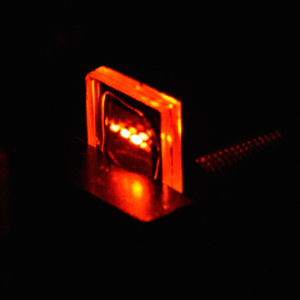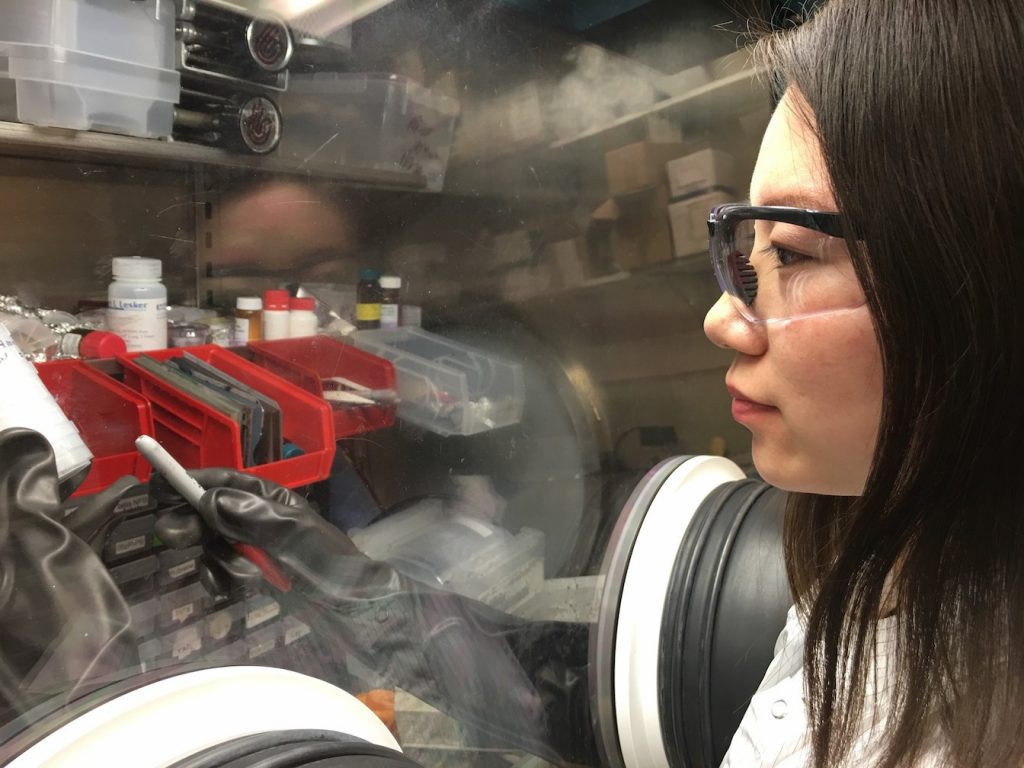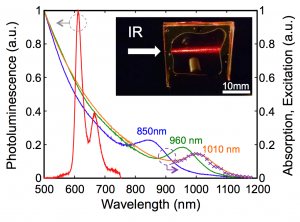Researcher Spotlight
Turning the Infrared into the Visible - MIT-Harvard Center for Excitonics
Optoelectronic devices such as solar cells and light emitting diodes based on thin films of excitonic materials are of great interest to MIT graduate student, Mengfei Wu. Unlike traditional semiconductors, which are made of a rigid and extended lattice of atoms, excitonic materials usually consist of smaller units, such as molecules or clusters of atoms known as nanocrystals. These materials can be dissolved and processed in solutions, or evaporated thermally. As a result, they can be coated as thin films on large-area flexible substrates, enabling technologies such as curved television or phone displays and lightweight solar cells. Mengfei believes that a better understanding of these excitonic materials will lead to more efficient solar cells, light sources, displays, and image sensors.
Her research focuses on using excitonic materials to convert infrared light into visible light, a process known as photon upconversion. Most solar cells, photodetectors and cameras in the market today are made of silicon. While silicon is rather efficient at capturing visible light, it does not absorb infrared photons with energy less than its bandgap. As a result, silicon-based solar cells have an efficiency ceiling of about 30%, losing a large part of the solar spectrum that is in the infrared. Turning infrared light into the visible can help solar cells capture more of the sunlight, thus making them more efficient. On the other hand, for sensing and imaging applications, expensive lower-bandgap semiconductors have to be used currently to detect infrared light. If they could be replaced with silicon, sensitized by a coating that turns infrared light into visible light, the cost of infrared sensors would be reduced significantly.
 Working with her colleagues, Mengfei has successfully demonstrated infrared-to-visible upconversion in a solid-state device [1,2]. The device consists of a thermally-evaporated thin film of rubrene molecules mixed with a small amount of emissive dye molecules, on top of a thin film of colloidal lead sulfide nanocrystals spun-cast from a solution. As seen in the picture on the right, when the device is shone with an invisible infrared beam, it produces a bright red glow wherever the beam lands. This enables one to visualize an invisible beam directly. Similarly, a solar cell or a detector, when coupled with such an infrared-to-visible upconversion device, can “see” the infrared light that it normally is unable to capture.
Working with her colleagues, Mengfei has successfully demonstrated infrared-to-visible upconversion in a solid-state device [1,2]. The device consists of a thermally-evaporated thin film of rubrene molecules mixed with a small amount of emissive dye molecules, on top of a thin film of colloidal lead sulfide nanocrystals spun-cast from a solution. As seen in the picture on the right, when the device is shone with an invisible infrared beam, it produces a bright red glow wherever the beam lands. This enables one to visualize an invisible beam directly. Similarly, a solar cell or a detector, when coupled with such an infrared-to-visible upconversion device, can “see” the infrared light that it normally is unable to capture.
Here’s how the device works: the nanocrystals absorb incident infrared photons and go into an excited state, forming the so-called excitons. These excitons transfer energy to the rubrene molecules resting on top of the nanocrystal film, thereby exciting the molecules to form spin-triplet excitons. As excited rubrene triplets interact with each other, some are promoted to a higher-energy singlet state through a process known as triplet-triplet annihilation. Those singlet excitons of rubrene further transfer energy to the emissive dye molecules, which then give away their energy as visible photons. In this process, the energy initially carried by an infrared photon is stored, transported, and doubled in the form of excitons in the various materials before being released as a visible photon.
Mengfei hopes to understand the intricate science behind infrared-to-visible upconversion and improve its efficiency. She has gained valuable insights into the chemistry and photophysics of colloidal nanocrystals and organic molecules by collaborating with members of the Excitonics center in the Bawendi’s and Van Voorhis’ groups. Together, they have produced devices that turn about 7% of absorbed infrared photons into visible photons.
Figure 1. Absorption of the lead sulfide nanocrystals can be tuned in different regions of the infrared spectrum by varying the nanocrystal size. All three sizes of nanocrystals shown above are able to sensitize the triplet state of rubrene, leading to triplet-triplet annihilation in rubrene and visible emission from the dye molecules embedded in rubrene. [1]
A native of China, Mengfei went to Singapore for high school on a scholarship. By the time she finished her undergraduate degree in Engineering at University of Cambridge, her mind was set on research with a keen interest in thin-film solar cells. “What drew me to MIT, among other options, were the faculty and students I met during the campus visit,” Mengfei recalls, “They were incredibly motivated and genuinely interested in learning and making a difference. I was greatly encouraged and wanted to work alongside them.” She began her graduate studies at MIT in the fall of 2013, co-advised by Professor Marc Baldo and Professor Vladimir Bulović in the Department of Electrical Engineering and Computer Science.
 An active member of the center, Mengfei is the center’s representative for the Energy Frontier Research Center’s (EFRC) Early Career Network (ECN). The ECN aims to promote interaction among students and postdocs across all the EFRCs through webinars on topics that are of interest to the members and informal meet-ups at national conferences. She coordinates three annual webinars and organizes the EFRC meet-ups at the MRS Spring and Fall Meetings. Sharing her research also ignites another area that Mengfei excels in: in 2016, she won the Best Presentation Award at EFRC Center for Excitonics All-Hands Meeting and the Best Research Pitch Award at MIT-MTL Annual Research Conference, and in 2017, she received the Nano Convergence Best Paper Award for her talk at the MRS Spring Meeting.
An active member of the center, Mengfei is the center’s representative for the Energy Frontier Research Center’s (EFRC) Early Career Network (ECN). The ECN aims to promote interaction among students and postdocs across all the EFRCs through webinars on topics that are of interest to the members and informal meet-ups at national conferences. She coordinates three annual webinars and organizes the EFRC meet-ups at the MRS Spring and Fall Meetings. Sharing her research also ignites another area that Mengfei excels in: in 2016, she won the Best Presentation Award at EFRC Center for Excitonics All-Hands Meeting and the Best Research Pitch Award at MIT-MTL Annual Research Conference, and in 2017, she received the Nano Convergence Best Paper Award for her talk at the MRS Spring Meeting.
Reflecting on her experiences of living in four different countries, Mengfei shares, “Although every move to a new place started with some fear of the unknown, I have learned to adapt quickly by embracing changes and making new friends. I’m grateful to my family and the many mentors and friends I’ve met along the way who have encouraged me to follow my heart and simply be myself.” When not working in the lab, she enjoys swimming, reading, and catching up with family and friends. Looking ahead, Mengfei is keeping an open mind. She hopes to continue doing research, possibly in the academia with opportunities to mentor students.
[1] M. Wu et al., Solid-state infrared-to-visible upconversion sensitized by colloidal nanocrystals. Nature Photonics 10, 31-34 (2016)
[2] M. Wu et al., Interference-enhanced infrared-to-visible upconversion in solid-state thin films sensitized by colloidal nanocrystals. Appl. Phys. Lett. 110, 211101 (2017)







